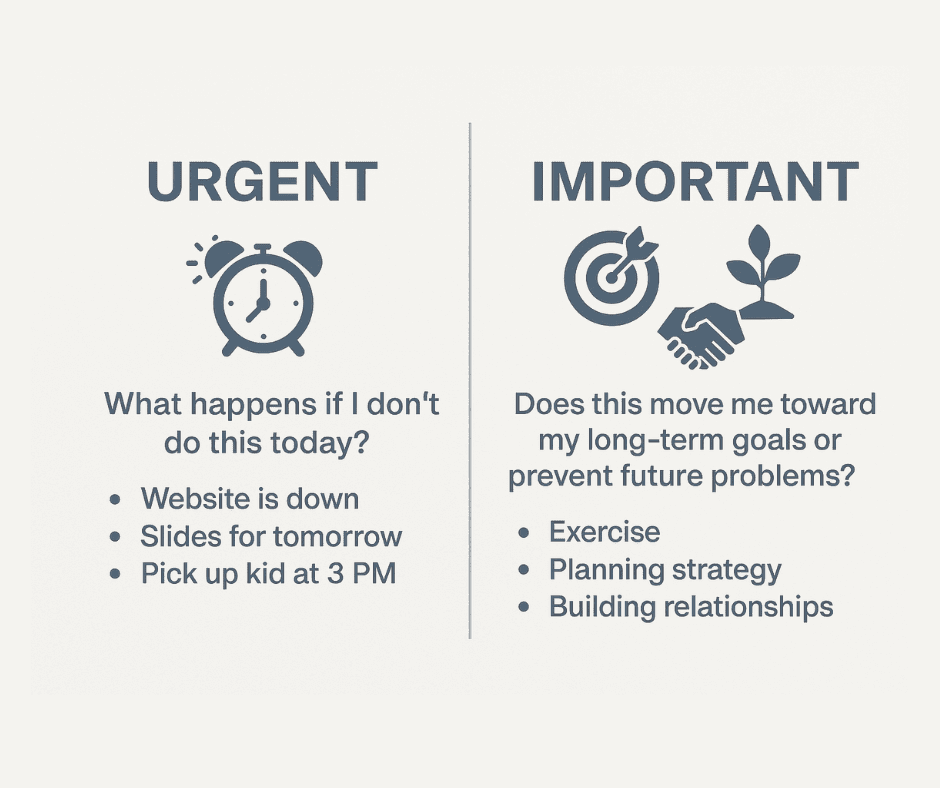What Is the Eisenhower Matrix and How It Transforms Your To-Do List

Your to-do list keeps growing faster than you can check things off. You finish one task, and somehow three more appear in its place. If this sounds like your typical Tuesday, you’re definitely not alone.
Most people live with this reality until something breaks. Maybe deadlines start colliding, or your manager expects everything done yesterday, and you finally realize you can’t actually do it all. When every task feels equally critical, you need a way to figure out what really deserves your attention first.
The Eisenhower Matrix gives you that clarity. It’s basically two simple questions: Is this urgent? Is this important? Your answers sort everything into four clear categories that tell you exactly what to do with each task.
This framework has been helping people make better priority decisions for decades. You’ll find it built into productivity apps like TickTick, Todoist, Notion, and ClickUp because it solves a problem that pretty much everyone has: figuring out what to work on when everything seems to demand immediate attention.
What is the Eisenhower Matrix?
The Eisenhower Matrix organizes your to-do list based on urgency and importance. That’s it. Two criteria, four categories, and suddenly you know what to do with each task.
The method gets its name from Dwight D. Eisenhower, who knew something about juggling priorities. As both a military leader and U.S. President, he had to figure out what actually needed his attention versus what just seemed urgent.
He once said something that stuck:
“I have two kinds of problems: the urgent and the important. The urgent are not important, and the important are never urgent.”
Dwight D. Eisenhower
Stephen Covey later turned this into a practical method in “The 7 Habits of Highly Effective People.” The matrix breaks down like this:
- Do first – Urgent and important tasks
- Schedule – Important but not urgent tasks
- Delegate – Urgent but not important tasks
- Delete – Neither urgent nor important tasks
What makes this system work is its simplicity. You stop treating every item on your list the same way. Instead, you quickly categorize each task and immediately know how to handle it.
How to tell if something is actually urgent vs. actually important

Most people struggle with the Eisenhower Matrix for one reason. They can’t tell the difference between urgent and important. Everything feels urgent when you’re overwhelmed. And when someone else asks for something, it automatically seems important.
Let’s clear this up.
The urgent task
Urgent tasks have real deadlines with real consequences. The key question is what specifically happens if this doesn’t get done today. Not what might happen, not what you’re worried about, but what actually happens.
Actually urgent stuff looks like:
- Your website is down and customers can’t buy anything
- Presentation slides for tomorrow’s client meeting
- Tax filing that’s due today
- Picking up your kid from school at 3 PM
Stuff that feels urgent but really isn’t:
- That email marked “urgent” with no actual deadline
- Someone asking for info that could wait until next week
- A meeting someone wants “ASAP” with no real reason
- Any task that feels pressing mainly because you’ve been avoiding it
- That text asking “Are you free?” without saying why
- The pile of laundry staring at you while you work
- Reorganizing your desk for the third time this week
The important task
Important tasks move you forward or prevent problems later. The question here is whether this actually advances your goals or stops something bad from happening down the road.
Actually important:
- Regular exercise (because health compounds over time)
- Learning skills that advance your career
- Planning your business strategy
- Building relationships with key people
- Fixing things before they break completely
Not as important as it seems:
- Busy work that fills time but creates no value
- Tweaking finished projects endlessly
- Going to every meeting you’re invited to
- Responding to every single request
- Organizing stuff that works fine already
The tricky combinations
Some tasks seem to fit multiple categories, and that’s where people get stuck.
Urgent but not important tasks usually come from other people’s poor planning. Your coworker forgot about a deadline and now it’s your emergency? Maybe not. Before you drop everything, figure out if this truly needs immediate action or if someone just wants it that way.
Important but not urgent tasks get ignored constantly. They don’t make noise. They don’t send notifications. But these quiet tasks (exercise, planning, learning, relationship building) often determine whether you succeed or just survive. I’ll admit this quadrant was my blind spot for a while. These tasks kept getting bumped by whatever felt urgent that day.
Then there are tasks that create fake urgency through emotion. Someone sends a snippy email and suddenly you need to respond RIGHT NOW. But do you? Taking a breath usually shows these aren’t urgent or important. They’re just loud.
The four ways to handle every task on your list

Now that you know urgent from important, sorting becomes straightforward.
Do first (urgent and important)
These are real emergencies. Actual fires that need putting out. But here’s the thing: if everything is always on fire, you’re probably letting important stuff turn into crises.
What belongs here:
- Server crash affecting customer orders
- Medical emergency
- Critical bug blocking everyone’s work
- Contract deadline that’s actually today
- Safety issue that could hurt someone
Just handle these immediately. But also notice patterns. Too many crises usually means you’re not spending enough time on prevention.
Schedule (important but not urgent)
This is where good things happen. These tasks don’t scream for attention, but they matter most for your success and sanity.
What goes here:
- Exercise and health stuff
- Learning new skills
- Strategic planning
- Building relationships
- Maintenance before things break
- Projects you actually care about
Put these on your calendar like real appointments. Protect that time. The urgent stuff will try to steal it, but don’t let it.
Delegate (urgent but not important)
These have deadlines but don’t need your specific skills. They’re often about serving someone else’s priorities, not yours.
Examples:
- Data entry anyone could do
- Scheduling routine meetings
- Basic research tasks
- Following up on standard requests
- Formatting documents
Find someone else to handle these. If you can’t delegate, at least batch them together and knock them out quickly. Don’t let them interrupt important work.
Delete (neither urgent nor important)
Time wasters. They feel productive but accomplish nothing real.
The usual suspects:
- Endless social media scrolling at work
- Meetings with no clear purpose
- Perfecting something that’s already done
- Reading every single newsletter
- Organizing your already-organized desk
Yes, that includes tweaking the font on a finished presentation. We’ve all been there.
Just stop doing these things. Seriously. Delete them from your list and move on.
Step-by-step: Turn your overwhelming list into a clear plan
Let’s get practical. Here’s how to actually use this with your current mess of tasks.
1. Brain dump everything
Get it all out of your head. Every task, every nagging thing, that appointment you keep forgetting. Write it all down using paper, app, whatever works. Don’t organize yet. Just dump.
If your tasks live in different places (email, Slack, sticky notes everywhere), gather them in one spot first. You can’t prioritize what you can’t see.
2. Ask the two questions for each item
Go through your list. For each task: Is it urgent? Is it important?
Be honest. That report your manager mentioned “whenever you get to it” isn’t actually urgent, even if it feels that way. And just because someone asked nicely doesn’t make their request important to your goals.
Don’t overthink this. Make a quick call and move on. You’ll get better at it.
3. Sort into the four categories
Make four lists:
- Do first: Urgent and important
- Schedule: Important but not urgent
- Delegate: Urgent but not important
- Delete: Neither
You’ll probably be surprised. Tasks that felt critical might be neither urgent nor important. And that project you’ve been avoiding? Might be the most important thing on your list.
4. Take action based on category
Now you know what to do:
Start with “Do first” tasks and get them off your plate. Then protect time for “Schedule” tasks before the urgent stuff steals your whole day. Look for ways to hand off “Delegate” items. And actually delete the “Delete” tasks instead of letting them hang around making you feel guilty.
The “Schedule” category is where most people fail. These important-but-not-urgent tasks get pushed aside every single day. Don’t let that happen. They’re usually the difference between progress and just being busy.
Using the Eisenhower Matrix with your current tools
So you’ve sorted your tasks and know what goes where. Great. But how do you actually track all this without creating another complicated system?
Good news, the Eisenhower Matrix works with whatever you’re already using.
Digital apps that support it
Several apps have this built right in:
TickTick has dedicated Eisenhower Matrix views where you can drag tasks between quadrants. I find the card view particularly helpful here because I can actually see my tasks laid out in the four quadrants instead of staring at an endless list. There’s something about that visual separation that makes it obvious which tasks don’t actually matter that much.
Todoist lets you create labels for each category (@urgent-important, @important-only, etc.) and filter your tasks to see each quadrant.
Notion works great if you add urgency and importance properties to your task database, then create filtered views for each quadrant.
ClickUp and Asana have priority levels you can map to the four categories, plus custom fields if you want to get fancy.
Even basic tools work. Google Tasks or Apple Reminders can handle this if you just create four separate lists.
Paper methods
Honestly? A piece of paper divided into four squares works perfectly. Some people prefer this because there’s no app to fiddle with, no notifications, just you and your priorities.
Use different colored pens for each category if you want. Or sticky notes you can move around as things change. Some people make a fresh matrix every morning on an index card they carry around.
Whatever you do, make the categories visually obvious. You should see at a glance where your time is going.
Team applications
Teams can use this during planning meetings to agree on what’s actually important. When everyone understands the framework, you stop arguing about priorities and start making decisions.
Create a shared board where everyone can see how tasks are categorized. This prevents the classic problem where everyone thinks their request is urgent and important.
Before saying yes to new projects, run them through the matrix. Is this work actually important, or just keeping people busy?
How to make better priority decisions over time
The matrix seems simple enough, but using it well takes practice. Think of it like learning to cook. At first you follow the recipe exactly, then you develop instincts for what works.
Building judgment through practice
Pay attention to which categorization decisions work out well and which ones don’t. If you consistently put tasks in “Do first” that could have waited, you might be overestimating urgency. I learned this when I realized I was treating every email marked ‘urgent’ as actually urgent. Once I started questioning those labels, my ‘Do first’ quadrant became much more manageable.
Notice your patterns. Maybe you always think certain people’s requests are important when they’re really not. Or you keep ignoring maintenance tasks until they become emergencies.
Track what happens to tasks over time. If important things keep becoming urgent crises, you need to protect more time for prevention.
Recognizing your personal biases
We all have blind spots that mess with our priorities.
People pleasers think every request is urgent and important. If you’re constantly handling other people’s emergencies, this might be you.
Perfectionists turn simple tasks into major projects. Sometimes done really is better than perfect.
Adrenaline junkies actually like the “Do first” quadrant because crises feel productive. But that rush isn’t sustainable, and it keeps you from doing the quiet, important work that prevents crises.
Once you see your patterns, you can correct for them.
Is the Eisenhower Matrix right for you?
The matrix isn’t some rigid law. It’s a tool that should work for you, not the other way around. If certain tasks never fit cleanly into categories, make your own rules for handling them.
Some people add time estimates to distinguish between similar tasks. Others score the impact of important tasks to prioritize within categories. Whatever helps you decide.
Try different approaches until something clicks. Not everyone thinks in quadrants, and that’s totally fine. The real value is in asking those two questions—urgent? important?—however you organize the answers.
The point is finding a way to stop the urgent from drowning out the important. If the Eisenhower Matrix does that for you, perfect. If you need to modify it or try something completely different, that’s fine too. What matters is that the important stuff stops getting buried under the merely loud.





